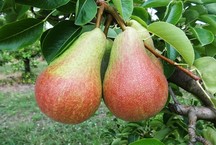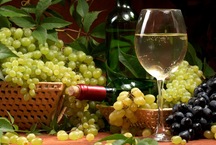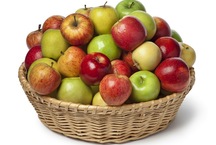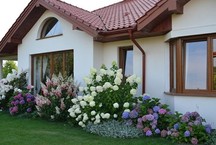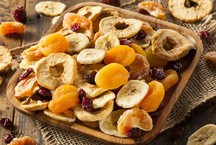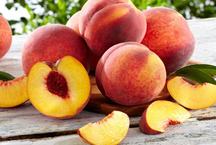Top 10 apricot varieties


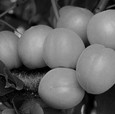
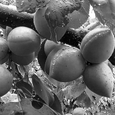

Apricot in Central Russia, and even in the Southern Urals, is no longer an exotic fruit. It winters, grows, blooms and bears fruit. But many gardeners will say otherwise: often freezes, the tree is short-lived, overwintered flower buds can completely die from the spring frosts, the fruits of resistant varieties do not suit the taste. Therefore, it cannot be argued that apricot growing in Russia is easy. The best varieties of apricot reviews gardeners from different regions are presented in our ranking.
How to choose the best grade apricot?
Main problems with apricots in the Moscow Region and the Middle Band: root neck heating, low winter hardiness and vulnerability of early blooming flowers. The first problem is solved by planting on a mound and using seedlings grafted onto hybrid cherry plum or white plum.
Poor fruiting is observed when grafting on a sand cherry (besseyu), and seedlings on Manchurian apricots are prone to podvoprivanii. Many summer residents grow own-rooted seedlings of apricot, which, due to good adaptation, produce regular and abundant crops.
The apricot root system has a high frost resistance and rarely freezes out even in the conditions of the Urals. Difficulty in another: apricot short rest periodtherefore, after January, during a long thaw period, the kidneys quickly wake up and become vulnerable. The problem of low winter hardiness can be partially solved only by planting zoned varieties. Even experiment lovers rarely decide to plant even very good, but not regionalized apricot varieties.
It is a misconception that the apricot varieties from Siberia and the Urals will winter successfully in the Middle Belt. Siberian varieties are faster than European ones that awaken during the period of thaw and are more damaged. They are adapted for conditions with harsh winters and tolerate low temperatures well, being in forced rest. In the middle zone, frost resistance apricot is not as important as winter hardiness.
Apricots are predominantly self-fertile, but there are quite a few self-fruitful varieties requiring a pollinator. This should be taken into account when selecting varieties: if you plan to plant 5 - 6 varieties, then there will be no difficulties with pollination in any case, but if only 2 - 3, then it is better to choose self-bearing.
Rating the best varieties of apricot
| A place | Name | Rating | Price |
|---|---|---|---|
| 1 | Triumph of the north | 9.9 / 10 | 450 |
| 2 | Tsarsky | 9.8 / 10 | 800 |
| 3 | Favorite | 9.8 / 10 | 800 |
| 4 | Academician | 9.8 / 10 | 600 |
| 5 | Amur | 9.8 / 10 | 600 |
| 6 | Saratov Ruby | 9.8 / 10 | 400 |
| 7 | Dessert | 9.8 / 10 | 600 |
| 8 | Alyosha | 9.7 / 10 | 400 |
| 9 | Manitoba | 9.7 / 10 | 800 |
| 10 | Compote | 9.7 / 10 | 800 |
|
Triumph of the north
450 (one-year sapling)
Opens our ranking of the best varieties of apricot known variety with southern and Trans-Baikal "blood". The tree is powerful, tall, with a spreading crown. Shows self-fertility. Fruits are oval, widened in the middle, weighing 55 - 60 g, with pubescence, orange with a protrusion on the side and a red blurred blush. The flesh is soft-melting, juicy, sweet, for fresh use. Stone with a sweet core and almond flavor. Peel of medium density, sour. Flower buds show average winter hardiness. Prophylactic treatments for moniliasis are needed. With good care, fruiting begins at 4 - 5 years after planting. Zoned in the Oryol, Lipetsk, Tambov, Kursk, Voronezh and Belgorod regions. Grown in the south of Moscow region. Main advantages:
Minuses:
|
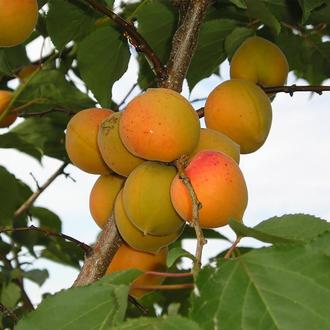 9.9 / 10
Rating
Reviews
In Voronezh, the Apricot Triumph demonstrates excellent characteristics. I do not consider him fastidious. |
|
Tsarsky
800 (two-year-old in a container)
Early ripe promising apricot variety for the Central region. Trees are of medium height. Fruits are oval, yellow with a blush, weighing 20 - 25 g, with a thick skin, pubescent.The pulp is dense, juicy, sweet with pleasant sourness, fragrant. Stone of medium size, freely separated. Fruits are well kept. For frost and winter hardiness suitable for the suburbs. Good results were obtained by gardeners of St. Petersburg. Main advantages:
Minuses:
|
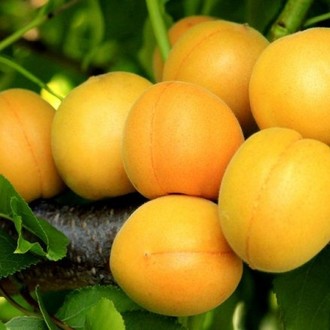 9.8 / 10
Rating
Reviews
My apricot is grafted on the plum, it does not bear fruit every year, but in our conditions we should not expect anything else. Much depends on the microclimate. |
|
Favorite
800 (two-year-old in a container)
New popular variety apricot late ripening. Tree medium height, compact crown. Fruits are round, slightly pubescent, orange with an intense broad blush, weighing 30 - 40 g. The pulp is dense, juicy, heterogeneous, bright orange, dessert taste. The stone is small, easily separated. In the Central Region, this apricot variety shows good winter hardiness. Due to late ripening in cold and rainy summer, the fruits may not have time to ripen. Main advantages:
Minuses:
|
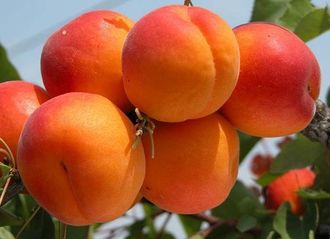 9.8 / 10
Rating
Reviews
Very tasty fruit, without exaggeration, "southern taste" apricot. It is worth having it at least in vaccination to feast on the end of the season. |
|
Academician
600 (two year old sapling)
Mid-season large-fruited apricot variety Far Eastern selection. A tall tree with an oval crown. Partial self-fertility is manifested, pollinator (Khabarovsk or Amur) is required to increase the yield. Fruits are oval, with a pronounced beak, slightly pubescent, orange with a reddening blush, weighing 30 - 60 g. The flesh is light, soft-juicy, medium density, sweet-sour. Stone medium size, well behind the flesh, with a sweet core. Fruits in wet weather do not burst. Lasts up to 7 days, suitable for transportation. Landings near water bodies freeze slightly. To the main diseases shows moderate resistance. Main advantages:
Minuses:
|
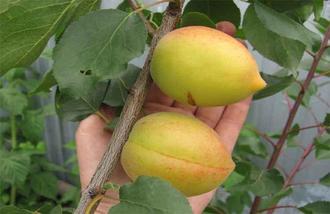 9.8 / 10
Rating
Reviews
It tolerates frosty winters, blooms even after damage. |
|
Amur
600 (two year old sapling)
Good reliable Far Eastern variety apricot. Trees sredneroslye, with a thick oval crown. It has a low degree of self-fertility, therefore it plucks individual fruits without a pollinator. The fruits are oval, with a thin beak at the top, weighing 25 - 35 g, firmly held on a short and thick stalk, sunny yellow with a bright blush on the side and dark dots. Pulp dry, dense, crunchy, sweet with pronounced acidity. The bone is medium, with a smooth surface, freely separated, has a sweet core. Fruits satisfactorily tolerate near transportation, do not crack in rainy weather. There is a relative resistance to moniliosis. For mutual pollination planted in a group with Khabarovsk and Academician. According to gardeners, this variety apricot winters well and blooms in the Tambov and Moscow regions, in the southern Urals is considered the most fruitful and tasty. Main advantages:
Minuses:
|
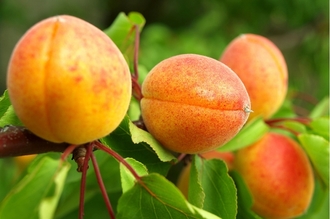 9.8 / 10
Rating
Reviews
In the Southern Urals, it bears fruits every year, it is quickly restored when frosting, but it will suffer in conditions of wet winters. |
|
Saratov Ruby
400 (one-year sapling)
Prospective apricot variety of medium ripening. Tall trees form a spherical crown. Shows partial self-fertility, therefore planting of a pollinator or grafting in the crown of other varieties with the same flowering time is desirable. The fruits are round-oval, light orange with an extensive bright ruby-colored blush, velvety, weighing 40 - 50 g. The flesh is soft, bright orange, dryish, sour-sweet. The stone is small, it separates well, the kernel is with weak bitterness.Fruits are resistant to cracking, tolerate transportation well, they remain more than 30 days when cooled. This apricot is interesting for its increased winter-resistance of flower buds. In the Volga region blooms even after “wet” winters. It is resistant to moniliasis. It is being tested in different areas of the Middle Band. Main advantages:
Minuses:
|
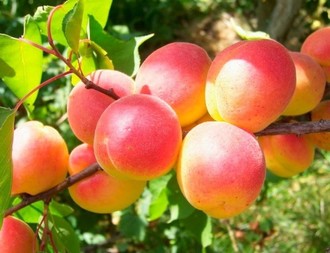 9.8 / 10
Rating
Reviews
Fruits are sweet, pulp without fibers, but there is no apricot flavor. |
|
Dessert
600 (two-year sapling with open root system)
Amateur early flowering variety with French genes. A tall tree (4 - 5 meters), with a spherical dense crown. It is self-fertile. Fruits are sunny yellow, evenly colored, often without a blush, rounded, slightly compressed from the sides, weighing 30 - 40 g. The flesh is tender, fragrant, light yellow, sweet with pleasant sourness. The stone is small, freely separated. The skin is thin, with weak pubescence. Fruits are transportable, in an unripe form remain up to 1 week. Shows good winter hardiness. Suitable for cultivation in the Central region, has been distributed throughout the central zone. Main advantages:
Minuses:
|
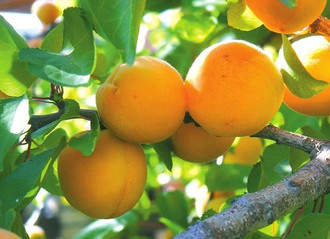 9.8 / 10
Rating
Reviews
In Nizhny Novgorod, this apricot shows enviable vitality, gives good gains. |
|
Alyosha
400 (one-year sapling with closed root system)
Further, in the ranking of the best varieties, apricot is a relatively new, universal, early ripe apricot variety for the Central region. Srednerosloy tree forms a dense spherical crown. During the flowering period is highly decorative. It is self-fertile. Fruits are round, flattened on the sides, bright yellow with a red speck, weighing 20 g, with weak pubescence. The flesh is dense, brightly colored, sweet and sour. The bone is large, freely separated. Fruits are well stored after harvest. In the Moscow region shows sufficient winter hardiness. After frost damage is quickly restored. An early onset of fruiting. Major diseases are moderately affected, prophylactic treatments are required. Main advantages:
Minuses:
|
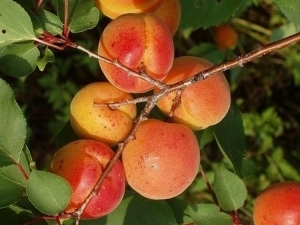 9.7 / 10
Rating
Reviews
An interesting sort of apricot for the Moscow region. We use for processing. Gives good gains. |
|
Manitoba
800 (two-year sapling with closed root system)
An old Canadian late-ripening apricot variety, in breeding, acts as a donor of winter hardiness. The tree is large, up to 5 meters high, with a sprawling and dense crown. Summer residents note increased decorativeness during flowering. Fruits are oval, with an elongated sharp "nose", with an average weight of 40 - 50 g (with twice more pruning), orange with a small blush, with strong pubescence. The flesh is tender, sweet, with weak sourness. The bone is large, free, has a bitter core. Apricot Manitoba is undemanding to care, but the crown needs annual pruning. It is characterized by high frost resistance and sufficient winter hardiness. Suitable for growing in the middle lane. Good results were obtained in the Saratov, Volgograd and Moscow regions. Main advantages:
Minuses:
|
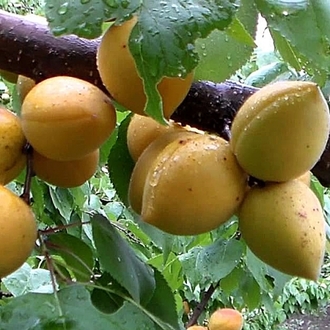 9.7 / 10
Rating
Reviews
Good, hardy and strong growing apricot variety. In my garden is a reliable pollinator for other later varieties. |
|
Compote
800 (two-year-old in a container)
Stable, self-fertile and productive variety for processing. Triumph of the North participated in his selection. The strong-growing tree forms a compact crown.It belongs to the late maturing varieties. The fruits are yellow with an extensive bright coral blush, rounded, weighing 35 - 45 g. The flesh is crisp, dense, sweet and sour. Stone is average, with a bitter core. When preparing compotes, the fruit retains its shape, the pulp does not fall apart. Prized for high winter hardiness, including flower buds. Later flowering reduces the risk of freezing of buds and flowers. Rarely affected by diseases and resistant to podprievaniyu. Suitable for cultivation in the Central Black Earth region, has proved itself well in the Volga region. Main advantages:
Minuses:
|
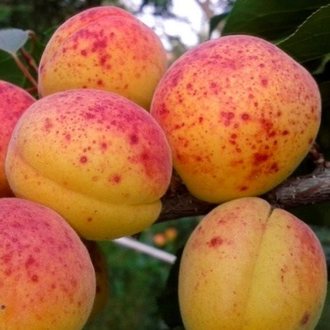 9.7 / 10
Rating
Reviews
Compote apricot grows quickly, recovers well. The taste is pleasant: we eat with pleasure from the tree. |
Choosing the right variety is half way. Next stage - search for a bona fide nursery, excluding the transfer. Unfortunately, buying high quality seedlings is even more difficult than choosing a worthy variety. Experienced gardeners plant cuttings of interesting forms in the crown of a plum or apricot seedling.
Apricots bloom before other fruit trees. To reduce the risk of damage by spring frosts, for planting choose southern, elevated and protected from the wind areas near buildings.
For the apricot is very important microclimate and soil type. Before buying a seedling you need to prepare the best place on the site and consult with experts or read scientific literature. This will help avoid gross errors and wasted money and time.
The preferred planting time for apricot is spring. For the season, the seedling will take root, give growth and prepare for winter. Autumn planting in the Central zone is associated with a high risk of death of the seedling.
Have a good harvest!
